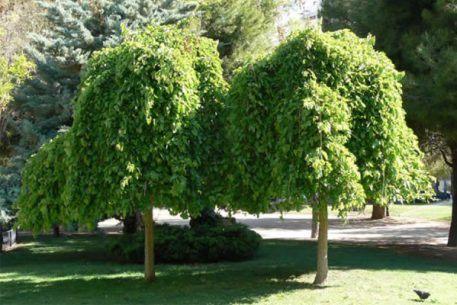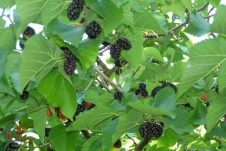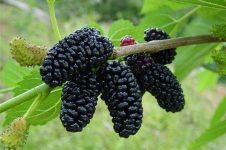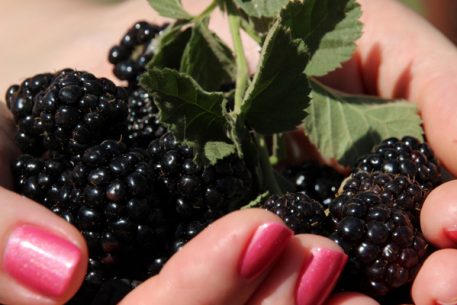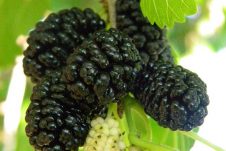Deciduous mulberry tree or mulberry stores many mysteries. It has the longest life expectancy among fruit plants, comparable only with coniferous trees. Healing properties are possessed not only by the fruits, but also all parts of the plant, they have long been used in folk medicine to treat ailments.
Material Content:
Varieties, description

Mulberry is a tree from the Mulberry family, has 17 species. Currently, breeders have bred about 400 plant varieties. Most often, black and white mulberries are grown.
Popular varieties:
- Istanbul black - medium ripening, with dense sweet berries of dark purple, almost black. The height of an adult tree is more than 3 m, the weight of berries is 6–10 g. It blooms in April, the crop begins to ripen in July. The tree is frost-resistant, withstands cold up to -35 ° C. An adult tree brings up to 100 kg of crop per year.
- Surprise is a late ripening period with an extended fruiting period. The berries are black, large, up to 3 cm in length, have a pleasant sweet taste. The tree is fast-growing, resistant to frost and disease.
- Korolevskaya is the largest variety, black berries, up to 6 cm long, can weigh 20 g. The mulberry is quick-growing, berries are tied in the first year after planting (two-year-old seedlings). Harvest ripen in June. The tree is medium-sized, with a spreading, dense crown, not afraid of drought and frost.
- Black Prince - comes into fruition for 2 years after planting. Large-fruited variety, berries up to 5 cm, black, very sweet and juicy. The tree is frost-resistant, tolerates drought well.
- Smolenskaya pink is an early, frost-resistant variety with fragrant small berries of red or pink color.Beautiful foliage allows you to grow a tree as a decorative culture.
- White honey - an early variety, gives an abundant crop, which ripens in June. The berries are medium sized, juicy and sweet. The variety is self-fertile and frost-resistant. A medium-sized adult tree begins to bear fruit for 4–5 years.
Where does the mulberry tree grow and what does it look like
Mulberry is a tropical tree that takes root and grows well in central Russia. It has beautiful leaves, the fruits are somewhat reminiscent of a blackberry, only much sweeter, with a faint aroma. In China, the mulberry has been cultivated for about 3 thousand years. In Russia, by decree of Peter I, cutting down of this crop was prohibited.
In the southern regions, where the mulberry tree grows in comfortable conditions, its height reaches 15 meters and its life expectancy is 300–500 years. The name mulberry comes from the word silk, once it was the main source of this fabric. The silkworm, which creates cocoons from continuous silk thread, feeds only on white mulberry leaves.
Features of growing mulberries

In the northern regions, it is better to plant mulberry on sparse soil, so that the growing season is short. The place should be on the south side of the site, well-lit. For good survival, the roots of the seedling are treated with any root.
For good fruiting make feeding. In the spring - nitrogen, in the summer - organic, in the fall - phosphate and potash.
The tree blooms in late spring, so it is not afraid of spring frosts. In spring, frozen shoots are cut off, thanks to this, the crown begins to branch well. Even after severe frosts, the plant is well restored, and the fruits of the mulberry tree may appear on the shoots of the current year.
What are the benefits of a tropical tree?
In the Caucasus, the plant is called the king berry for its healing properties. The composition of the fruits are many substances useful to the body.
The chemical composition of mulberries:
- Sahara;
- tannins (in green fruits);
- minerals (K, Na, Fe, Zn, Mg, Ca);
- resveratrol;
- organic acids;
- vitamins (A, B1, B2, B3, B6, B9, K).
Resveratrol is one of the most powerful antioxidants. Berries have a lot of potassium.
Useful properties of mulberry:
- diuretic and diaphoretic;
- astringent;
- blood purifying;
- antiseptic;
- antipyretic (leaves);
- • anti-inflammatory.
The immature fruits of the mulberry have astringent effects, while ripe ones, on the contrary, have a slightly laxative effect.
Harvest usually ripens in July or August, and flowering begins in May and ends in June.
Mulberry is used in folk medicine for such diseases:
- with a cold;
- with hypertension;
- with heart disease;
- with diarrhea;
- From cough;
- with bronchitis and asthma;
- with fever.
Healing are all parts of the plant.
Black mulberry juice is an effective cough suppressant diluted with water, it is used to gargle with angina.
In China, the bark of branches and roots are used to prepare decoctions for high blood pressure.
Mulberry leaves are used to treat fever. They are collected during flowering - in May or June, dried, and used for 1 year. The bark of the branches is harvested in the spring, and the bark of the roots in October.
Berries are picked during ripening - in July or August. They make jam, wine, and are used in cooking as a sweet filling for pies. If harvested for future use for medicinal purposes, use drying or freezing. The temperature when drying berries should not exceed 45 ° C. Store dried fruits in glass jars for no more than 2 years.
Contraindications and harm of the mulberry to the body
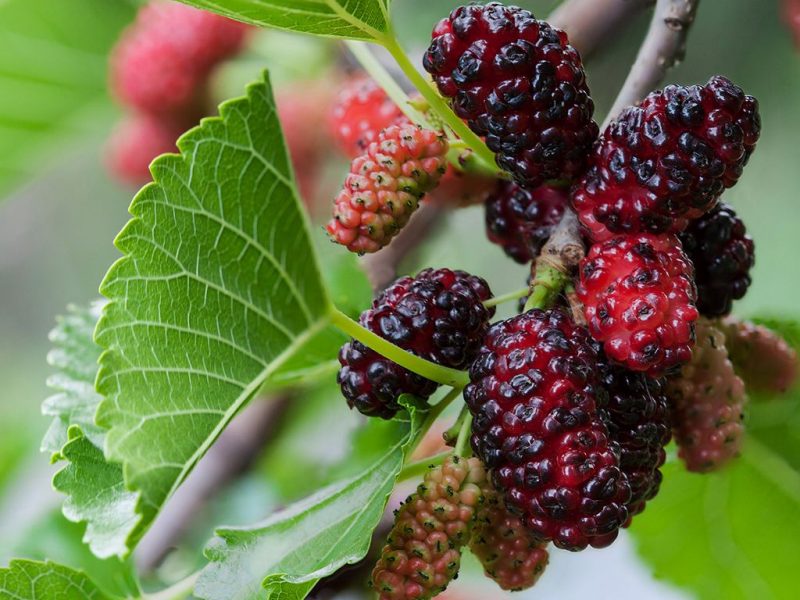
Mulberry berries are tasty and healthy, but there are limitations in their use for several reasons:
- diabetes - a high content of easily digestible carbohydrates leads to an increase in blood sugar;
- obesity - increases appetite, it is more difficult to follow a diet;
- hypertension - berries can increase pressure;
- allergy - there is an individual intolerance to mulberry.
It is undesirable to eat ripe berries in large quantities, this can cause diarrhea.
Mulberry is a very grateful plant, in response to care, it will delight the annual harvest of healthy and tasty berries, and in the summer heat it will give a saving shadow. The tree does not require special care, its leaves, fruits and bark can be used for medicinal purposes.


